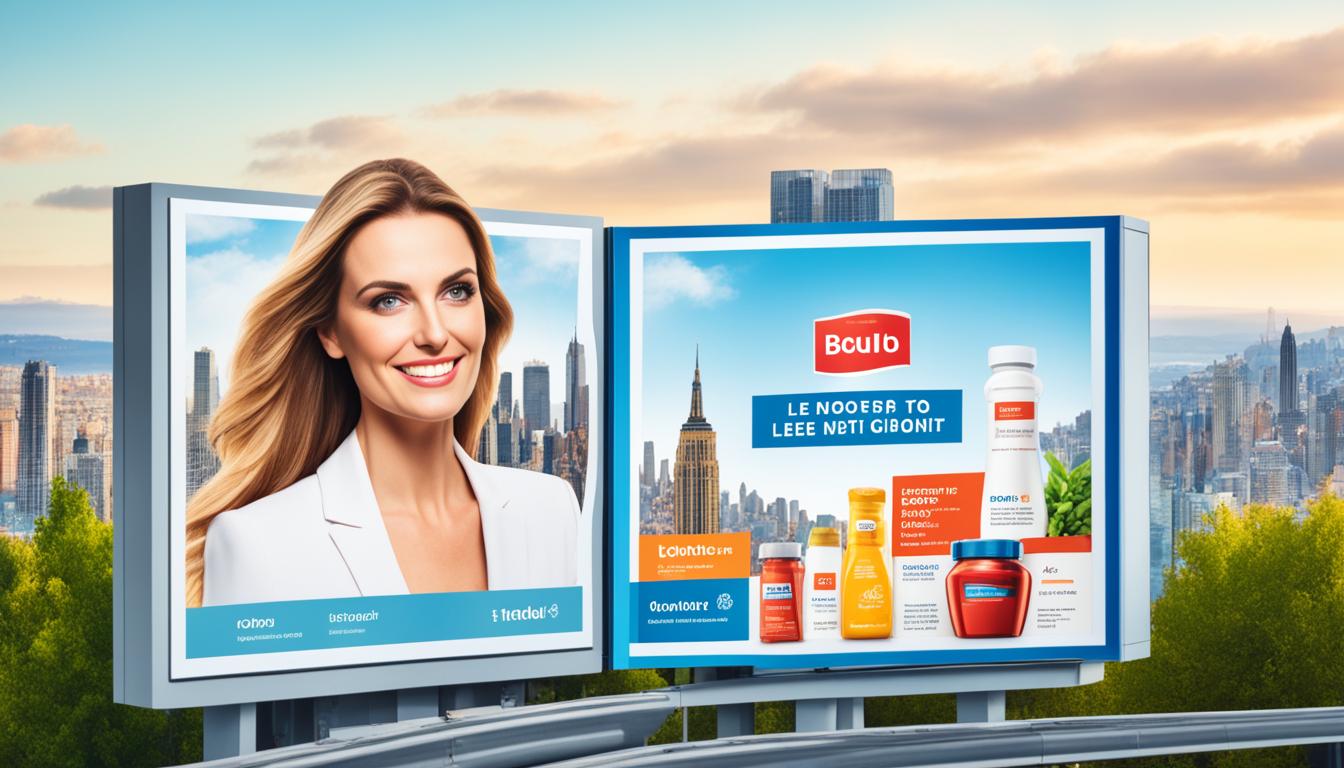Out of home advertising (OOH) is a powerful marketing strategy that extends beyond the confines of traditional digital platforms to reach consumers in the real world. It encompasses a range of visually impactful advertisements, such as billboards, bus shelters, and posters, strategically placed in high-traffic areas to capture audience attention.
Unlike digital advertising, OOH ads cannot be ignored or blocked by ad blockers, making them highly effective in conveying brand messaging and generating awareness. These ads are seamlessly integrated into the physical environment, blending with the everyday surroundings of consumers and creating a lasting impression.
OOH advertising complements digital campaigns, providing a tangible and unavoidable presence that reinforces brand messages across multiple touchpoints. It offers advertisers the flexibility to be creative in their messaging, leverage location-based targeting, and even purchase ad inventory in real-time to maximize campaign effectiveness.
Key Takeaways
- OOH advertising refers to marketing strategies that reach audiences outside their homes through visually impactful ads.
- It includes billboards, bus shelters, and posters placed in high-traffic areas to capture consumer attention.
- OOH ads cannot be easily ignored or blocked, making them highly effective in conveying brand messages.
- By complementing digital campaigns, OOH advertising reinforces brand messaging across multiple touchpoints.
- Advertisers can leverage creativity, location-based targeting, and real-time ad inventory purchasing to maximize campaign effectiveness.
Types of OOH advertising examples
When it comes to out-of-home (OOH) advertising, there are several different types that brands and marketers can utilize to reach their target audience. These examples of OOH advertising encompass a variety of locations and formats, allowing advertisers to choose the best options to suit their specific campaign goals.
1. Billboards
Billboards are one of the most well-known and impactful forms of OOH advertising. These large-scale print advertisements are typically placed in high-traffic areas, such as highways and urban centers. The size and visibility of billboards make them highly effective in catching the attention of passing motorists and pedestrians.
2. Busses
Busses offer a unique and mobile advertising space. Ads can be displayed on the exterior of the bus, effectively reaching a wide audience as the vehicle travels through city streets and populated areas. This form of OOH advertising allows brands to target consumers during their daily commute and capture their attention during a captive moment.
3. Posters
Posters are smaller in size compared to billboards but still play a significant role in OOH advertising. They can be found in various areas, such as public transportation stations and shopping centers, where they have the potential to reach a captive audience. Posters are versatile and can be strategically placed to target specific demographics or locations.
4. Tube System
The tube system, particularly in urban areas, presents another opportunity for OOH advertising. Brands can leverage the high volume of commuters in subway and metro systems by displaying ads on platforms, escalators, and the interior of trains. The tube system allows for targeted and repeated exposure to a diverse audience.
5. Airports
Airports provide a unique environment for OOH advertising due to the large number of passengers and dwell time. Brands can take advantage of various advertising opportunities within airports, including digital screens, billboards, and even baggage claim areas. Targeting a captive audience, airport advertising allows brands to leave a lasting impression on travelers.
6. Street Furniture
Street furniture refers to items such as benches, bus shelters, and kiosks found in public spaces. These structures offer valuable advertising real estate for brands to display their messages. Street furniture ad placements are strategically located to attract the attention of passersby and provide convenience and utility to consumers.
These are just a few examples of the diverse range of OOH advertising options available to brands. By utilizing these various formats in different locations, advertisers can create impactful campaigns that effectively reach and engage their target audience.
Benefits of out of home advertising
Out of home (OOH) advertising provides numerous benefits for advertisers, making it a valuable component of marketing campaigns. This form of advertising offers distinct advantages that set it apart from digital advertising, acting as a powerful complement to digital strategies.
Impact on Consumers: OOH ads have a significant impact on consumers due to their size and contrast to the real-world environment. With their larger-than-life presence, OOH ads are difficult to ignore, capturing the attention of passersby and leaving a lasting impression.
Complement to Digital Advertising: OOH advertising works in synergy with digital advertising, creating a seamless brand experience for consumers. Studies have shown that after being exposed to an OOH ad, consumers are more likely to engage with a digital advertisement, enhancing the effectiveness of digital campaigns.
Alternative to Digital Advertising: OOH advertising offers an alternative to digital advertising, overcoming some of its limitations. Unlike online ads that can be blocked by adblockers or lost in the overwhelming sea of information, OOH ads provide a tangible and unavoidable presence in the real world.
With these benefits, OOH advertising effectively increases a brand’s visibility, drives business growth, and reaches a wide audience of consumers. By combining the advantages of impact, complementarity, and tangibility, OOH advertising proves to be a valuable and effective marketing tool.
Expertly designed OOH campaigns have the power to captivate audiences, deliver messages with impact, and achieve marketing objectives. The subsequent section will explore various types of OOH advertising examples, showcasing the versatility and wide-ranging reach of this powerful marketing medium.
What you can do with out of home
Out of home (OOH) advertising provides advertisers with a powerful platform to create impactful campaigns that capture the attention of consumers. With its large canvas and unavoidable presence, OOH ads offer endless opportunities for creativity and messaging that can’t be ignored.
One of the key advantages of OOH advertising is its ability to leverage data and interactivity to create personalized and engaging campaigns. Advertisers can tap into the rise of data-driven advertising and the growing interactivity of OOH media to target specific audiences and deliver relevant content.
Location-based targeting is another significant aspect of OOH advertising. By understanding the demographics and behaviors of nearby consumers, advertisers can strategically place their ads in locations that will resonate with their target audience. This precise targeting ensures that OOH ads are seen by the right people at the right time.
In addition, the digitization of OOH advertising has revolutionized the industry by enabling real-time purchasing and adaptability to consumer surroundings. Advertisers can now easily access and purchase OOH ad inventory, making the entire process more convenient and faster than ever before.
The Power of Impactful Advertising Campaigns
With OOH advertising, brands have the opportunity to create powerful and memorable campaigns that leave a lasting impact on consumers. OOH ads are inherently attention-grabbing due to their size, boldness, and lack of distractions. This makes them highly effective in conveying brand messages and increasing brand awareness.
Creativity in OOH Advertising
OOH advertising offers a wide range of creative possibilities. From visually stunning billboards to interactive augmented reality experiences, advertisers can let their creativity run wild. Successful OOH campaigns often have a unique and innovative approach that captivates audiences and sparks positive brand associations.
Location-Based Targeting for OOH Advertising
The location-driven nature of OOH advertising allows advertisers to target their ads based on the demographics and behaviors of nearby consumers. This targeted approach ensures that OOH ads are displayed in locations where they are most likely to resonate with the intended audience. By reaching the right people in the right place, advertisers can maximize the effectiveness of their campaigns.
Real-Time Purchasing and Adaptability
Digitization has streamlined the process of purchasing OOH ad inventory, enabling real-time purchasing and adaptability to consumer surroundings. Advertisers can quickly access available inventory, make purchases on the spot, and adapt their campaigns based on real-time insights. This agility and flexibility contribute to the overall effectiveness and success of OOH campaigns.
| Benefits of OOH Advertising |
|---|
| Increased brand awareness |
| Highly impactful and attention-grabbing |
| Complement to digital advertising |
| Precise location-based targeting |
| Real-time purchasing and adaptability |
Trends in out of home advertising
In the ever-evolving world of advertising, out of home (OOH) advertising continues to adapt and innovate. Let’s explore some of the latest trends shaping the OOH industry:
Digital Out of Home Advertising (DOOH)
One prominent trend in the OOH industry is the rise of digital out of home advertising (DOOH). Utilizing digital screens and triggers, DOOH allows for more dynamic and personalized messaging. This digital format enables advertisers to showcase captivating visuals, videos, and interactive content, enhancing engagement with their target audience.
Programmatic Buying of OOH Media
Another significant trend is the emergence of programmatic buying in OOH advertising. Historically, OOH media buying involved manual processes, but programmatic technology has revolutionized the way ad inventory is purchased. Now, advertisers can automate the buying process and access OOH inventory on similar platforms as other digital ads, streamlining and simplifying their campaigns.
Attribution and Measurement in OOH
In the past, measuring the impact of OOH campaigns was challenging. However, recent advancements in technology have empowered advertisers with improved attribution and measurement capabilities. They can now track impressions, analyze consumer responses, and evaluate the effectiveness of their OOH ads accurately. This data-driven approach helps advertisers make informed decisions and optimize future campaigns.
These trends in DOOH, programmatic buying of OOH media, and enhanced attribution and measurement are reshaping the OOH industry. Advertisers are leveraging these advancements to create more engaging and impactful campaigns, reaching their target audience with precision and driving business growth.
Image illustrating the dynamic nature of digital out of home advertising
Tips for OOH campaigns
In order to create successful out-of-home (OOH) campaigns, it is important for marketers to leverage data-driven strategies and focus on creating shareable content. By incorporating these tips, OOH campaigns can be more effective and generate higher returns on investment (ROI).
1. Utilize Data for Targeted Advertising
Data plays a crucial role in OOH campaigns, allowing marketers to make informed decisions and optimize their advertising strategies. By leveraging first-party data and utilizing programmatic buying, advertisers can target specific audiences and deliver personalized messages. This data-driven approach ensures that OOH campaigns reach the right people at the right time, maximizing their impact.
2. Create Shareable Campaigns
Creating shareable campaigns is essential for generating buzz and word-of-mouth marketing. When OOH ads are engaging and memorable, they have a higher chance of being shared on social media platforms, extending their reach and exposure. By designing creative and captivating OOH ads, marketers can increase the chances of their campaigns going viral and gaining widespread attention.
Image: Shareable OOH Campaigns
3. Learn from Successful Examples
Studying successful OOH campaigns can provide valuable insights and inspiration for marketers. For instance, Netflix has created witty billboard ads that capture attention and spark conversations among viewers. Oreo has also utilized posters to creatively depict landmark events, generating interest and engagement. By analyzing and learning from these examples, marketers can develop their own unique and shareable OOH campaigns.
| Successful Shareable OOH Campaigns | Brand | Description |
|---|---|---|
| Witty Billboard Ads | Netflix | Netflix’s humorous and attention-grabbing billboard ads have gone viral on social media platforms, creating buzz and generating brand awareness. |
| Creative Posters | Oreo | Oreo’s creative use of posters to depict landmark events and cultural moments has garnered attention and encouraged consumer engagement. |
Table: Successful Shareable OOH Campaigns
By incorporating data-driven strategies and focusing on creating shareable content, marketers can optimize their OOH campaigns and achieve greater success. These tips, coupled with creativity and innovation, can help brands make a lasting impact on consumers and drive business growth.
What is outdoor advertising?
Outdoor advertising, also known as out-of-home advertising (OOH), refers to advertisements displayed in public spaces that people encounter outside of their homes. It includes a wide range of formats, such as billboards, signage, and digital screens. Outdoor advertising offers numerous benefits for advertisers and marketers looking to maximize their reach and impact.
One of the primary advantages of outdoor advertising is its high visibility. OOH ads are strategically placed in areas with high foot or vehicular traffic, ensuring that they are seen by a large audience. These ads cannot be easily ignored or blocked like digital advertisements, allowing brands to make a lasting impression on consumers.
The impact of outdoor advertising on consumers is significant. With their larger-than-life presence, OOH ads stand out in the physical environment and capture attention. They provide a tangible and unavoidable advertising presence in the real world, creating awareness and fostering brand recognition.
Outdoor advertising acts as a complementary channel to digital advertising. While digital advertising primarily targets consumers in their online or digital spaces, OOH advertising reaches them in the physical world. This combination allows advertisers to create a holistic marketing strategy that covers both the digital and physical realms, maximizing their chances of connecting with their target audience.
To provide a visual representation, here is a table comparing outdoor advertising and digital advertising:
| Outdoor Advertising | Digital Advertising |
|---|---|
| Offers high visibility in public spaces | Targets consumers in online/digital spaces |
| Makes a significant impact on consumers | Relies on ad placement and targeting algorithms |
| Complementary to digital advertising | Primary advertising medium in the digital age |
Overall, outdoor advertising provides an effective and tangible way for brands to convey their messages and connect with consumers. Its high visibility, impact on consumers, and complementary nature to digital advertising make it a powerful tool in the marketing toolkit.
Why choose outdoor advertising?
Outdoor advertising is a highly effective marketing strategy that offers numerous advantages and can significantly impact consumer behavior. With its high visibility, creative freedom, and ability to target specific locations, outdoor ads have proven to be a powerful tool for boosting brand awareness and driving business growth. Unlike digital ads that can be easily ignored or blocked, outdoor ads have a tangible presence in the real world, making them difficult to overlook and enabling them to make a lasting impression on consumers. In fact, studies have shown that outdoor advertising has a significant impact on consumer behavior, leading to increased brand recognition and purchase intent.
One of the key advantages of outdoor advertising is its high visibility. Whether it’s a larger-than-life billboard or an eye-catching poster, outdoor ads capture people’s attention and create a memorable brand presence. They can reach a wide audience and become an integral part of the urban landscape, offering continuous exposure to potential customers. This visibility helps build brand awareness and establishes a strong brand identity in consumers’ minds.
Another advantage of outdoor advertising is the creative freedom it allows for impactful messaging. With the large canvas of billboards, bus shelters, and posters, advertisers have the space to be imaginative and convey their brand message in a visually compelling way. They can use striking visuals, bold colors, and clever slogans to communicate their brand personality and engage audiences effectively. This creative approach makes outdoor ads more memorable and helps them stand out from the crowd.
In addition to high visibility and creative freedom, outdoor advertising also offers the advantage of targeting specific locations. Advertisers can strategically choose the places where their target audience is most likely to be present, whether it’s a busy urban street or a suburban shopping center. This targeted approach ensures that the message reaches the right people at the right time, increasing the likelihood of conversion and driving meaningful engagement.
Notable companies like Apple, Google, and Facebook recognize the effectiveness of outdoor advertising and extensively utilize it in their marketing campaigns. This underscores the relevance of outdoor advertising, even in the digital age. The combination of offline and online advertising channels enhances brand visibility and extends the reach of marketing efforts.
In conclusion, outdoor advertising offers undeniable advantages in terms of effectiveness, creativity, and impact on consumer behavior. Its high visibility, creative freedom, and ability to target specific locations make it a valuable marketing tool for businesses across industries. By leveraging the power of outdoor advertising, brands can establish a strong presence, engage with their target audience, and ultimately drive business growth.
| Advantages of Outdoor Advertising |
|---|
| High visibility |
| Creative freedom for impactful messaging |
| Ability to target specific locations |
| Extensive reach and brand recognition |
| Influence on consumer behavior |
Types of outdoor advertising
In the world of outdoor advertising, there are two main categories: traditional OOH formats and digital OOH advertising. Let’s explore the advantages and features of each.
Traditional OOH Formats
Traditional outdoor advertising has been a staple in the industry for years. It includes iconic formats such as billboards, posters, and street furniture. Billboards are large, attention-grabbing displays that can be found in high-traffic areas, making them an effective way to reach a wide audience. Posters, on the other hand, are smaller in size and can be seen at bus stops, train stations, and other public spaces. Street furniture includes items such as benches, bus shelters, and phone booths which have designated advertising spaces.
Digital OOH Advertising
Digital out-of-home advertising (DOOH) has revolutionized the industry with its dynamic and interactive capabilities. Digital screens have replaced static imagery, allowing for eye-catching visuals that can engage viewers in real-time. These digital displays can be found in locations such as shopping centers, airports, transit hubs, and even on the sides of buildings. Digital OOH ads offer several advantages, including:
- Vibrant Visuals: Digital screens can display high-resolution images and videos, capturing viewers’ attention with their striking visuals.
- Real-Time Targeting: With digital OOH advertising, ads can be targeted based on various factors like time of day, weather conditions, or even the demographics of the surrounding area. This allows for more personalized and relevant messaging.
- Interactive Experiences: Digital screens can incorporate interactive elements such as touchscreens, augmented reality, or gamification, providing a unique and engaging experience for viewers.
Overall, digital OOH advertising has opened up a world of possibilities for creativity and audience engagement, enhancing the impact of outdoor advertising in the digital age.
Image: Digital OOH advertising showcasing vibrant visuals and real-time targeting.
Data and targeting in outdoor advertising
Data-driven OOH ads, audience targeting in OOH advertising, and measurement in OOH campaigns are essential components of successful outdoor advertising strategies. By harnessing the power of data, advertisers can optimize their campaigns and ensure they reach the right audience at the right time.
One key aspect of data-driven OOH advertising is the availability of mobile data and geofencing. This allows advertisers to gather valuable insights into the whereabouts of their target audiences. By understanding where their target audiences are, advertisers can strategically place their OOH ads in locations that maximize exposure and engagement. This targeted approach not only increases the effectiveness of the ad campaigns but also optimizes ad spend.
In addition to mobile data and geofencing, first-party data and audience measurement platforms provide valuable insights into audience composition and engagement with OOH ads. These platforms allow advertisers to measure the impact of their OOH campaigns accurately. By analyzing audience demographics, impressions, and engagement metrics, advertisers can refine their strategies and make data-driven decisions to improve campaign performance.
The convergence of data and OOH advertising brings more precision and accountability to the industry. By leveraging data-driven OOH ads and audience targeting techniques, advertisers can create highly personalized and relevant ad experiences. This level of personalization not only increases the effectiveness of the campaigns but also enhances the overall customer experience.
Benefits of Data-Driven OOH Ads and Audience Targeting in OOH Advertising
Data-driven OOH ads and audience targeting provide several benefits to advertisers and brands:
- Increased campaign effectiveness: By leveraging data, advertisers can create targeted campaigns that resonate with their desired audience, resulting in higher engagement and conversion rates.
- Maximized ad spend: With audience targeting, advertisers can optimize their ad placements and ensure they reach the most relevant audience, maximizing the return on their investment.
- Improved audience engagement: Personalized and relevant OOH ads captivate audiences, increasing the likelihood of interaction and brand recall.
- Enhanced campaign measurement: Audience measurement platforms provide valuable insights into campaign performance, allowing advertisers to measure the impact of their OOH ads and make data-driven optimizations.
- Increased accountability: Data-driven OOH ads bring more transparency and accountability to the industry by enabling advertisers to measure the effectiveness of their campaigns accurately.
By leveraging data-driven OOH ads and audience targeting in OOH advertising, brands can optimize their campaigns, improve ROI, and create impactful ad experiences that resonate with their target audience.
| Data-driven OOH Ads and Audience Targeting | Traditional OOH Ads | |
|---|---|---|
| Targeting | Data-driven targeting allows advertisers to reach specific demographics, interests, and locations. | Traditional OOH ads have broader reach but lack the precision of data-driven targeting. |
| Personalization | Data-driven OOH ads can be highly personalized, delivering tailored messaging to individual consumers. | Traditional OOH ads typically have standardized messaging and visuals. |
| Measurement | Audience measurement platforms provide insights into campaign performance, allowing for data-driven optimizations. | Measurement of traditional OOH ads is limited to factors like visibility and impressions. |
| Flexibility | Data-driven OOH ads can be adapted and updated in real-time based on audience behavior and feedback. | Traditional OOH ads are static and cannot be easily modified once displayed. |
| Engagement | Data-driven OOH ads can be interactive, encouraging audience engagement through features like QR codes or augmented reality. | Engagement with traditional OOH ads is limited to visual impact and brand recall. |
Conclusion
OOH advertising offers a unique and impactful way to reach consumers outside of their homes. With its high visibility and creative messaging, OOH campaigns have the power to leave a lasting impression on audiences. Moreover, the ability to target specific locations adds an extra layer of relevance to these campaigns, ensuring that the right message reaches the right audience.
In recent years, the rise of digital out-of-home (DOOH) advertising and programmatic buying has brought even more opportunities to the industry. The integration of digital screens and data-driven strategies allows for more dynamic and personalized campaigns. This evolution in OOH advertising opens up new creative possibilities and enables advertisers to deliver engaging experiences that capture consumer attention.
Looking ahead, the future of outdoor advertising is bright. As technology continues to advance, we can expect to see even greater innovation in the OOH space. From the incorporation of augmented reality to the use of real-time data for targeting, the possibilities are endless. The growing demand for OOH campaigns in the digital age highlights the effectiveness and continued relevance of this advertising medium.
By leveraging the power of OOH advertising, marketers can revolutionize their brand’s visibility and drive business growth. With its ability to complement digital advertising and its unmatched impact on consumer behavior, OOH campaigns are an essential component of any comprehensive marketing strategy. As the industry evolves and embraces new technologies, the future of outdoor advertising will undoubtedly be characterized by increased personalization, interactivity, and engagement.



